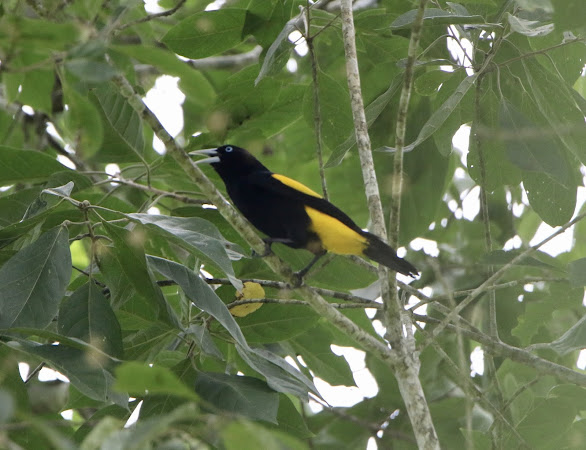They make large, hanging nests from plant fibers and grasses which they weave for such. It appears they range in lengths of 2-4 feet long - the Oropendulas make the larger ones as would be expected. As you’ll see from the pictures, they have an opening on the top and are larger on the bottom where the eggs are laid and where adult birds will brood them. We have to assume an adult bird is a little cramped in the nest, its tail curled around as there simply is not enough room to straighten it out. Some of the caciques will build their nests in very close proximity to a large wasp nest. This is believed to deter predators such as monkeys, squirrels and large birds like toucans.
A similar bird to the blackbird family are the cowbirds, of which there are several species. The largest one is the Giant Cowbird of the American tropics.
 |
| Giant Cowbird |
This family of birds (Cowbirds) are parasites, in that they lay their eggs in the nest of other birds (parasitize) and in many situations the host species will brood and raise the cowbirds along with their own babies. Sometimes the other birds will dislodge cowbird eggs from their nest. Other times they may built another nest over the top of the present one. But often they will accept the eggs are their own, and often to the detriment of their own babies.
On my 2nd walk up the river I found a colony of Yellow-rumped Caciques. Their were 15 nests that I could count, implying a total of 30 birds.
 |
| Yellow-rumped Cacique |
They were coming and going. I saw them entering and exiting the nest holes so assumed babies were being fed. They were about 75 meters away, so my photos reflect the distance - nothing real close. All the nests were hanging on a large bamboo stalk, and I’d say the distance was about 20 feet between the first and last. In the midst was a very large wasp nest, and my camera even captured a few in some frames. I immediately suspected there must be a benefit to the birds.
It was fascinating to watch them. Some would appear to strut their stuff by ruffling their yellow feathers when another bird flew in, maybe a minor territorial gesture. Often they came back to the colony in small groups, squawking and carrying on. I wish the walk there was a little closer as I’d like to visit it again, but I was pretty famished by the time I got back from that walk, so probably not. And now the river is higher with all the rains.
About 10 days later I was walking along on the Colibri Road and I heard a cacique off to the north side of the road, and when I looked that direction I viewed another colony about 125 meters away. It was on the far side of a field of young banana trees. I felt I could get much closer to this one than the last, so struck out through the weeds and other growth. I was able to get to a tree to hide behind about 25 meters from the colony and was able to take better pics.
The building of nests here was in the making still, and birds were coming in with pieces of grass and other materials to do some weaving. They were often hanging upside down and poking the grasses into and around what they were forming which would soon become a pendulum type of nest.
Some appeared to have just been started while others looked finished. I counted 6 of them, and these, like the last colony, were built right next to a large wasp nest. I was sure this must be common practice for them now, so wrote to Rich Hoyer, a birding friend who has spent lots of time leading birding tours in South America, who explained to me that they do this to protect the colony from predators like monkeys and squirrels who would eat the eggs or young birds. Other info I gleaned included Toucans as predators. And some female caciques vie for the closest space to the wasp nest when planning to start their own nest.
The next time walking the jungle road, I looked over at the colony and saw a cacique chasing an equal sized bird away, which was all black, so I suspected it was a Giant Cowbird. Even when I was there photographing a few days prior I noticed a few squirmishes but could never determine what was going on, so maybe it was the same thing.
The 2nd day at my 2nd lodging a group of 8 caciques flew into the large tree outside the restaurant, but I’ve not seen or heard any since, so maybe they were just passing through. And during my birding forays I see a lone cacique here and there. I’ve found a number of bird nests and seen many birds carrying nesting material, so assume it is nesting season here, and it would appear it coincides with the rainy season.











No comments:
Post a Comment